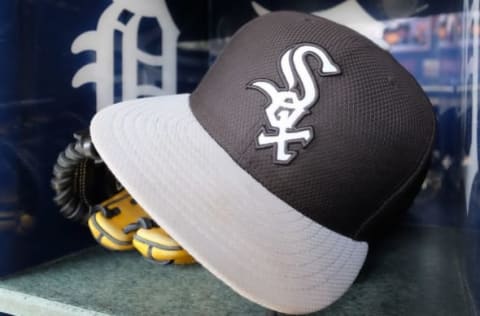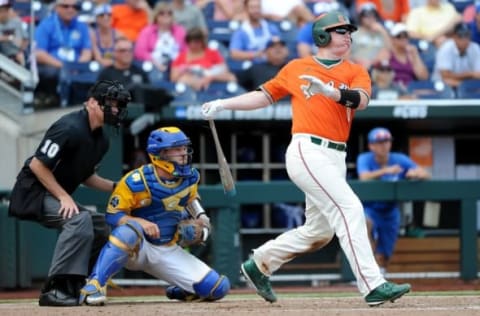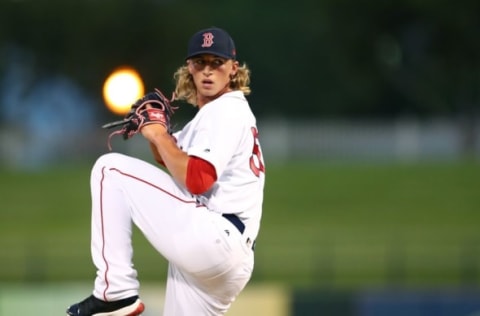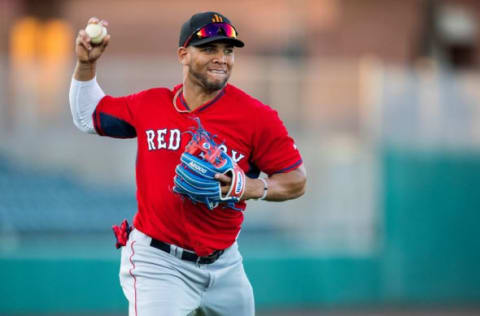Chicago White Sox REVISED Top 10 Prospects For 2017


The Chicago White Sox made a huge move to trade ace Chris Sale. How did the return impact their minor league system?
An Introduction
Our minor league top 10 series is coordinated by Benjamin Chase, one of our contributors at Call To The Pen.
He has poured over thousands of minor league games over the course of the year via milb.tv along with speaking with a number of team and independent scouts. These lists are based out of those conversations.
Each system will have prospects from 10 to 1, and then finish with one newcomer to the system that is worth keeping an eye on that is not in the top 10 at this time.
Conversations are certainly encouraged in the comments section on each system as we go along!
After taking big swing and misses on high athleticism in guys like Courtney Hawkins, the system is missing truly elite talent
White Sox System Review
One of the major reasons you’re hearing rumors about Jose Quintana, Todd Frazier, and many more being on the market this offseason has to do with the barren state that the team finds their farm system.
Even after the big Chris Sale trade, the White Sox still have a very shallow system, though they have now acquired some major top-end talent.
After taking big swing and misses on high athleticism in guys like Courtney Hawkins, the home-grown system is missing truly elite talent. Those types of players can turn into a solid player with extra development time, as seen with Trayce Thompson, but more frequently, they’re susceptible to an extremely high bust rate.
When it’s come to arms, the team has hit big with guys like Sale and Carlos Rodon, who both moved quickly through their system, but outside of that, the picks have been rough, to say the least. Their pursuit of high-velocity, big breaking ball college arms has produced those two, but it’s also led to some big fallout picks, which is tough to do when it’s a top 10 overall selection.
The White Sox will be intriguing to watch this offseason, and I would wager that they would be wise to pursue a trade of more quantity than quality in any further trades this offseason, and I’m sure their front office knows this. Teams like the Braves, Brewers, Padres, and Yankees have quickly jumped their systems to elite level by going for a wide swath of talent rather than one or two elite guys in a trade.
Let’s take a look at the top 10!
Next: #10
10. Jameson Fisher, OF
Birthdate: 12/18/93 (22 years old)
Level(s) Played in 2016: rookie
Stats in 2016: .342/.436/.487, 4 HR, 13 SB
It should be evidence to just how bad the White Sox system was coming into the season that four of my top ten were not in the system to start 2016. Fisher was the 4th round selection for the White Sox in June, and he’s another guy who may have been a smart scouting selection in what is shaping up to be a smart draft by the ChiSox.
Fisher was a catcher until surgery to repair a torn labrum in college, and while there doesn’t seem to be any push to move him behind the plate, it has led to Fisher having a different understanding of the zone than most hitters you’ll see in their first pro season.
He had a tremendous season in 2016 for Southeastern Louisiana, leading D-1 in on-base percentage and finishing in second in batting average. He has a very good contact tool, and many considered his hit tool to be the best among college players in 2016.
many considered his hit tool to be the best among college players in 2016
Fisher has solid power and fringe average speed, so his 13 steals is probably not something you’ll see long-term, but Fisher is a smart ballplayer, and he’ll likely get more steals than his raw speed would indicate due to smart base running.
After the labrum surgery kept him out for a year, Fisher is left with a below average arm, and his future role in the field is likely as a DH or a first baseman as he has minimal range in the outfield with that below average arm.
That will put additional pressure on Fisher’s bat, but in seeing him play, I really think Fisher has the bat to be a future passable DH, in the vein of a Billy Butler-esque production from the position.
Next: #9
9. Jordan Stephens, RHP
Birthdate: 9/12/92 (24 years old)
Level(s) Played in 2016: high A
Stats in 2016: 141 IP, 3.45 ERA, 1.26 WHIP, 8.16 BB%, 26.36 K%
Stephens is in line to put an end to the perception of Rice pitchers being poor choices in the draft after being a 5th round selection in 2015. The White Sox handled him gently in 2015 after a heavy workload with Rice, letting him only work short outings.
The gloves came off this season in the Carolina League as Stephens went deep in most of his starts, making 27 starts and from the 10th of May to the end of the season, he only had one start where he failed to complete the 5th inning, so he went deep each time out with solid results.
He may not have front-line sort of stuff, but Stephens should work well in the middle/back of a rotation
Stephens has a solid repertoire of pitches, with a fastball that sits in the low 90s, touching 96 with good plane when he stays on top of the pitch. His best pitch is a curve that gets tremendous depth, generating both swing and miss and weak contact. He throws a hybrid cutter/slider that took a big step forward in 2016 to be an above-average pitch. Finally, he has a change that still needs work as he struggles to get on top of the pitch in the same way he does his fastball, so it’s fairly easily picked up.
Stephens has some medical history to worry about, so the White Sox will need to be attentive to keeping his arm protected, but with his excellent control and solid pitch mix, Stephens is able to keep hitters off balance and guessing.
He may not have front-line sort of stuff, but Stephens should work well in the middle/back of a rotation with his pitch mix. He’ll get a bump to AA next year, and that will be an interesting progression for his stuff against advanced-level hitters.
Next: #8
8. Spencer Adams, RHP
Birthdate: 4/13/96 (20 years old)
Level(s) Played in 2016: high A, AA
Stats in 2016: 163 IP, 3.98 ERA, 1.29 WHIP, 4.46 BB%, 14.37 K%
While Carlos Rodon leaped from the #3 overall selection in 2014 to the major leagues quickly a fellow 2014 draftee may be the next guy to reach the majors as a future starter in Adams.
Adams had a big time repertoire as a high school prospect, touching 96-97 with his fastball and a borderline plus slider. That stuff has settled some as a pro, but in a way that has possibly made Adams a more likely future starter.
Adams’ big calling card is his control, as he’s totaled a 5/1 K/BB ratio in his minor league career thus far
Adams works with a solid four-pitch mix of a fastball that sits in the low-90s, a low-breaking slider, a looping curve, and a change that flashes plus, but sits at above average. Adams’ big calling card is his control, as he’s totaled a 5/1 K/BB ratio in his minor league career thus far.
While he may not be the guy the White Sox envisioned when they drafted him, his solid pitch mix should allow Adams to play up well with a very high floor of a #4 starter. He reached AA as a 20 year old in 2016, so possibly seeing a September call up in 2017 is not out of the realm of possibility at 21, which would be incredible development.
Adams has excellent athleticism and easy mechanics that should allow him to keep moving quickly through the White Sox system. He actually reminds me quite a bit from the right side of what Jose Quintana was when the White Sox signed him as a minor league free agent from the left side. If he can have a similar development, White Sox fans would be elated.
Next: #7
7. Luis Alexander Basabe, OF
Birthdate: 8/26/96 (20 years old)
Level(s) Played in 2016: low-A, high-A
Stats in 2016: .264/.328/.452, 12 HR, 25 SB
If you want to see 5 tools in action, catch a glimpse of Basabe. Part of a set of twins that the Red Sox signed in 2012 out of Venezuela (before trading his brother to Arizona this summer), Basabe has jumped up the Boston system, all the way to high-A as a teen in 2016. Now both are in other organizations.
Basabe’s tools all rate as future plus tools, with only his hit tool really still not showing as above-average at least in game play already. Even then, the hit tool has been showing at fringe average to average now.
Basabe’s tools all rate as future plus tools, with only his hit tool really still not showing as above-average at least in game play already
Basabe still needs work in his pitch recognition, and that is really the last step in his hit tool as well. Right now, the power and speed play extremely well in game.
Basabe has the speed and arm to handle any position in the outfield. His plus to plus-plus arm would rate well in right field, but he’s been playing center field at this point as he’s able to handle it for now.
Basabe will be an interesting one to watch in the next year as he could be a guy worthy of top-100 consideration or flame out fairly soon in his development. Regardless, this is a high level talent guy that the White Sox need to be targeting in acquisitions.
Next: #6

6. Carson Fulmer, RHP
Birthdate: 12/13/93 (22 years old)
Level(s) Played in 2016: AA, AAA, MLB
Stats in 2016: 103 IP, 4.63 ERA, 1.48 WHIP, 12.23 BB%, 22.71 K% (minor league stats only)
Seeing a guy drafted #8 overall just a summer ago already down to #4 in his own system (a system likely to only produce one top 100 player, if that) really puts the exclamation point on the state of the system.
Fulmer was a very volatile selection when the White Sox plucked him at #8 last summer out of Vanderbilt after he had moved from the bullpen the year before. He had plenty of red flags from scouts ahead of the draft due to his high-energy delivery that can quickly get off base.
Fulmer at his best works with a fastball that runs to 97 and a power curve
In his first season, he breezed through the year, and the White Sox were looking quite wise for their selection. In 2016, however, those mechanical concerns surfaced, and Fulmer struggled to maintain his delivery, struggling with his command, though his control stayed better than one would think.
Fulmer at his best works with a fastball that runs to 97 and a power curve that runs hard and with sharp break. The change is still a work in progress if he wants to remain a starter.
The White Sox brought Fulmer up as a reliever this season, and many feel that will be his future big league role, but he will need to find consistency in his mechanics before he can even be successful out of the bullpen.
Next: #5
5. Alec Hansen, RHP
Birthdate: 10/10/94 (22 years old)
Level(s) Played in 2016: rookie, low A
Stats in 2016: 54 2/3 IP, 1.32 ERA, 0.81 WHIP, 9.71 BB%, 39.32 K%
When we all look back at the 2016 draft, this is the guy who could look like the easy “steal” in the draft. Hansen was considered as one of the top 2-3 picks of the draft coming into the spring season for Oklahoma when his tall mechanics got out of whack, and he lost his rotation spot for Oklahoma before working his way back into the Sooner rotation. By then, many teams had dropped Hansen significantly on their list.
Hansen is a huge guy, standing 6’7 and 235 pounds listed. Many guys once you get past 6’5-6’6 have trouble with their mechanics getting off due to long arms and legs getting out of whack, and that’s exactly what happened with Hansen.
More from Chicago White Sox
- Chicago White Sox owner Jerry Reinsdorf finally cleans house, removing GM and EVP
- Chicago White Sox: Who belongs on the franchise’s Mt. Rushmore?
- Cleveland Guardians minor league affiliate hopping on the Tim Anderson fight aftermath
- MLB trade deadline: What comes next for Chicago White Sox?
- Chicago White Sox: Friday trades clearly point to future
Hansen works with a fastball that can flirt with triple digits, a slider that can break two planes, and a hard curve that works well for generating weak contact. His change as a pro even showed very well, flashing fringe-plus and certainly appearing as above-average.
This past spring is certainly something the White Sox will have to keep in mind as they move Hansen up the system, spending extra time keeping Hansen’s mechanics in line as he works his way up the system.
So far, however, he may be one of the most impressive performances from the 2016 draft, and I had a very difficult time picking him #3 instead of #2.
Next: #4
4. Zack Burdi, RHP
Birthdate: 3/9/95 (21 years old)
Level(s) Played in 2016: rookie, high A, AA, AAA
Stats in 2016: 38 IP, 3.32 ERA, 1.13 WHIP, 12.99 BB%, 33.12 K%
It’s really on pure proximity and raw stuff that I have Burdi this high. I’m typically not a fan of having a reliever this high on a list, even a “bad” system list.
Burdi was a college closer at Louisville, like his older brother Nick Burdi, who is in the Twins system. He doesn’t quite have the consistent triple digit velocity that his brother produced before injury this season, but he can reach 100 in his own right.
Burdi got a sizable bonus from the White Sox with the thought that he could move quickly through the system as a power reliever. The team was rewarded quickly as Burdi moved all the way to AA after just 6 professional innings.
More from Call to the Pen
- Philadelphia Phillies, ready for a stretch run, bomb St. Louis Cardinals
- Philadelphia Phillies: The 4 players on the franchise’s Mount Rushmore
- Boston Red Sox fans should be upset over Mookie Betts’ comment
- Analyzing the Boston Red Sox trade for Dave Henderson and Spike Owen
- 2023 MLB postseason likely to have a strange look without Yankees, Red Sox, Cardinals
Burdi has a fastball that runs into the upper 90s and a slider that breaks hard. He does have the type of clean delivery and an above-average change that would indicate the ability to start if the White Sox would choose to pursue that route as well.
The White Sox have gone the “reliever to rotation” route in the past with Sale, so they could pursue a similar path with Burdi, but his future as a reliever could be punched when he gets to the majors quickly, likely in 2017, and has success in the back of the bullpen.
Burdi is a guy who fell just outside my top 100, but he could be the one guy on this list that makes an impact at the ballpark formerly known as the Cell next season.
Next: #3

3. Zack Collins, C
Birthdate: 2/6/95 (21 years old)
Level(s) Played in 2016: rookie, high A
Stats in 2016: .244/.396/.435, 6 HR
With big worries about his ability to stay behind the plate, Collins was a volatile prospect for much of the draft season. As the draft got closer and teams were able to do individual workouts, it began to leak out from multiple clubs how impressive Collins was in his individual workouts with the tools of ignorance on.
He did hit like a mad man in college, whether or not he was having success behind the dish. He was originally drafted as a 27th-rounder by the Reds, but chose to attend Miami, and became arguably the best hitter in the nation last season, so the decision was a wise one.
Collins made significant strides in his lateral movement behind the plate, and some in the AFL have labeled Collins as the best framer in the Arizona Fall League
The White Sox grabbed Collins at #10 after he had scared off some teams with high contract demands, but he quickly got into camp, and he was able to really show his bat in his short time before going to the Arizona Fall League.
The big thing for Collins was his ability behind the plate. He’ll likely never be a Gold Glove catcher, and his arm will always be fringe average, but Collins made significant strides in his lateral movement behind the plate, and some in the AFL have labeled Collins as the best framer in the Arizona Fall League. That’s pretty big praise.
He’ll likely be the lone top-100 guy that’s consensus in the organization with some places possibly popping Fulmer or Burdi or even Adams, but many sticking with just Collins in the top 100. He’ll probably get a shot at AA to start in 2017, and his progress there will determine his timeline to the big leagues.
Next: #2

2. Michael Kopech, RHP
Birthdate: 4/30/96 (20 years old)
Level(s) Played in 2016: short-season A, high-A
Stats in 2016: 56 1/3 IP, 2.08 ERA, 1.10 WHIP, 14.67 BB%, 38.22 K%
Here’s what you need to know about Kopech: 105.
This summer, one of Kopech’s Salem teammates was charting one of his starts with the radar gun. He wrote down that number. 105 would be a modern record velocity, and it set baseball Twitter ablaze for a number of days and still gets talked about.
I don’t believe Kopech actually did throw 105. He’s never had a single 104 charted in his career, though he has had a couple of 103s and often throws 101 in a start. The thing that is most impressive is that a teammate that sees Kopech day-in and day-out saw 105 on the gun and didn’t think “that’s a tad high”. He simply logged it as the actual velocity!
the thing that is most impressive is that a teammate that sees Kopech day-in and day-out saw 105 on the gun and didn’t think “that’s a tad high”
Kopech isn’t just a fastball, either. He has a slider that flashes plus and routinely works as an above-average pitch, and his change up is a consistent, if mostly average, offering.
Where Kopech does struggle is in his delivery. In order to generate the velocity that he does, he has a significant amount of hard lean and movement in his delivery, and it can throw him off-balance if he gets too far, and that will throw off his control.
Kopech got headlines in the spring for getting in a fight with his teammate and breaking his pitching hand, but from all accounts, his teammates love him, and the incident this spring was an isolated issue.
Kopech has eased up some of the “violence” in his delivery present before this season, and with the level of athleticism he has, he should be able to maintain his delivery better going forward. His Arizona Fall League performance was one to watch for sure.
Kopech will be sent to the upper minors in 2017, most likely, and the White Sox absolutely got one of the most exciting arms in the game by pulling in Kopech.
Next: #1

1. Yoan Moncada, IF
Birthdate: 5/27/95 (21 years old)
Level(s) Played in 2016: high-A, AA, MLB
Stats in 2016: .294/.407/.511, 15 HR, 45 SB (minor leagues only)
Moncada came to the US from Cuba, and he’s hit the ground running since he got to the states. The Red Sox started him at high-A this year, but it quickly became clear that he was ready for a move up in league.
Moncada is built like an NFL safety, listed at 6’2 and 205 pounds, but probably more accurately about 215-220 with strong musculature.
His athleticism is obvious on the field. He has incredible bat control and his strength allows for the bat to launch off of his bat. He also has incredible speed. That combination is obvious in the combination of his 52 extra base hits and 45 stolen bases.
Moncada is a natural up the middle defender, and that could be a more natural fit for the White Sox than it was in Boston, where he was being shoe-horned into third base. He and Tim Anderson up the middle could be one of the more exciting young double play combinations in the league.
Moncada will likely be given every chance in spring to show that he deserves to open the season in the White Sox major league lineup, especially after headlining the trade for one of the more popular players in recent White Sox memory.
Next: Newcomer To Watch
Newcomer To Keep An Eye On: Alex Call, OF
Birthdate: 9/27/94 (22 years old)
Level(s) Played in 2016: rookie, low A
Stats in 2016: .308/.394/.600, 6 HR, 14 SB
Call was drafted out of Ball State in the third round in 2016. He hadn’t flashed much power before coming out big in 2016 in the collegiate season to hit 13 home runs and win the MAC player of the year.
He is an exceptional athlete that is a plus runner and has a plus arm, which allows him to handle defense very well. He played right field in college, but he showed in his pro debut that he could handle center field very well.
Call is not a guy with ideal build for power or speed, but he is put together very well to allow him to be a plus defensive outfielder. If he can simply provide average offense to go along with that, he’ll have a future.
That offensive upside is likely not heavy as he’s more a gap power guy as a professional than a guy who will hit a lot of home runs, and his speed is more the type that takes 2-3 steps to get going, so while it plays well in the outfield, he’s not likely going to be a guy who will be a great base stealer as he moves up the system.
Call was a guy who many viewing the draft, including myself, thought was undervalued when no one mentioned him as a possible pick in the first couple of rounds, and so far, he’s shown he has a chance to be a solid player as he develops.
Next: Red Sox Top Ten Prospects
Agree? Disagree? Someone you have a question about from the system? Leave a comment down below!